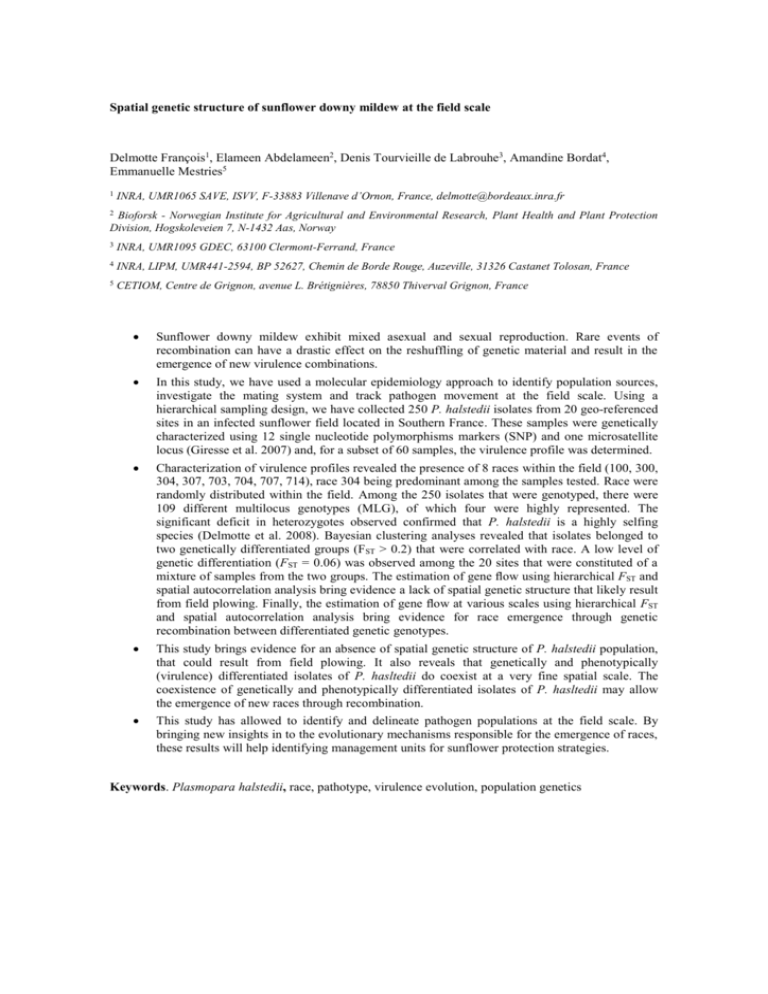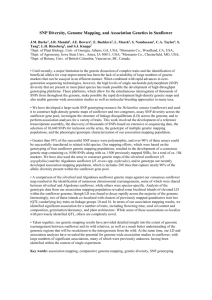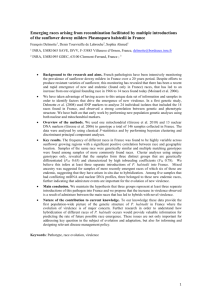Spatial genetic structure of sunflower downy mildew at the
advertisement

Spatial genetic structure of sunflower downy mildew at the field scale Delmotte François1, Elameen Abdelameen2, Denis Tourvieille de Labrouhe3, Amandine Bordat4, Emmanuelle Mestries5 1 INRA, UMR1065 SAVE, ISVV, F-33883 Villenave d’Ornon, France, delmotte@bordeaux.inra.fr 2 Bioforsk - Norwegian Institute for Agricultural and Environmental Research, Plant Health and Plant Protection Division, Hogskoleveien 7, N-1432 Aas, Norway 3 INRA, UMR1095 GDEC, 63100 Clermont-Ferrand, France 4 INRA, LIPM, UMR441-2594, BP 52627, Chemin de Borde Rouge, Auzeville, 31326 Castanet Tolosan, France 5 CETIOM, Centre de Grignon, avenue L. Brétignières, 78850 Thiverval Grignon, France Sunflower downy mildew exhibit mixed asexual and sexual reproduction. Rare events of recombination can have a drastic effect on the reshuffling of genetic material and result in the emergence of new virulence combinations. In this study, we have used a molecular epidemiology approach to identify population sources, investigate the mating system and track pathogen movement at the field scale. Using a hierarchical sampling design, we have collected 250 P. halstedii isolates from 20 geo-referenced sites in an infected sunflower field located in Southern France. These samples were genetically characterized using 12 single nucleotide polymorphisms markers (SNP) and one microsatellite locus (Giresse et al. 2007) and, for a subset of 60 samples, the virulence profile was determined. Characterization of virulence profiles revealed the presence of 8 races within the field (100, 300, 304, 307, 703, 704, 707, 714), race 304 being predominant among the samples tested. Race were randomly distributed within the field. Among the 250 isolates that were genotyped, there were 109 different multilocus genotypes (MLG), of which four were highly represented. The significant deficit in heterozygotes observed confirmed that P. halstedii is a highly selfing species (Delmotte et al. 2008). Bayesian clustering analyses revealed that isolates belonged to two genetically differentiated groups (FST > 0.2) that were correlated with race. A low level of genetic differentiation (FST = 0.06) was observed among the 20 sites that were constituted of a mixture of samples from the two groups. The estimation of gene flow using hierarchical FST and spatial autocorrelation analysis bring evidence a lack of spatial genetic structure that likely result from field plowing. Finally, the estimation of gene flow at various scales using hierarchical FST and spatial autocorrelation analysis bring evidence for race emergence through genetic recombination between differentiated genetic genotypes. This study brings evidence for an absence of spatial genetic structure of P. halstedii population, that could result from field plowing. It also reveals that genetically and phenotypically (virulence) differentiated isolates of P. hasltedii do coexist at a very fine spatial scale. The coexistence of genetically and phenotypically differentiated isolates of P. hasltedii may allow the emergence of new races through recombination. This study has allowed to identify and delineate pathogen populations at the field scale. By bringing new insights in to the evolutionary mechanisms responsible for the emergence of races, these results will help identifying management units for sunflower protection strategies. Keywords. Plasmopara halstedii, race, pathotype, virulence evolution, population genetics Introduction Early genetic studies of P. halstedii have addressed the pathogen population genetic and structure at large-geographical scales (Komjati et al., 2004; Intelmann, 2002; Spring & Zipper, 2006; Roekel-Drevet et al. 2003, Delmotte et al. 2008). However, there is still no data available concerning the genetic diversity of sunflower downy mildew at fine spatial scale. Indeed, sunflower downy mildew exhibit mixed asexual and sexual reproduction and rare events of recombination between pathotypes within a field could have a drastic effect on the reshuffling of genetic material resulting in the emergence of new virulence combinations. In this study, we have used a molecular epidemiology approach to assess spatial population genetic structure, investigate the mating system and track pathotype emergence at the field scale. Material and methods Hierarchical sampling design. The sampling was conducted in a production field of 14 ha in the Gers department (SW of France). We determined 20 plots of 50 m2 regularly distributed in the field, and for each plot we collected 6 different samples of soil. These soils samples were used to plant seeds of a sensitive sunflower variety and this protocol leaded to the isolation of 250 samples of sunflower downy mildew on sunflower cotyledons. The 250 samples were genetically characterized using 12 single nucleotide polymorphisms markers (SNP) and one microsatellite locus (Giresse et al. 2007, 2010) and, for a subset of 60 samples, the virulence profile (race) was determined. Genetic analyses were performed using a set of software including Geneclone (Arnaud-Haond & Belkhir, 2007), Adegenet (Jombart et al. 2008) and Structure (Pritchard et al. 2000) . Results Characterization of virulence profiles revealed the presence of 8 races within the field (100, 300, 304, 307, 703, 704, 707, 714). Race 304 was predominant (n=45) among the samples tested and was found in 18 of the plots samples. Races were randomly distributed within the field. The second most abundant race was 703 that was represented by 10 samples (Figure 1). Among the 20 plots, we observed the spatial coexistence of different races in seven of them, as in the plot S13 where 5 races were found in sympatry: 304, 703, 704, 707, 714. Among the 250 isolates that were genotyped, there were 109 different multilocus genotypes (MLG), i.e. the dataset included 41% of repeated genotypes. Four MLG were to be highly repeated in the dataset (n=48, n=32, n=26, n=15) and these MLG were genetically closely-related and all belonged to race 304. Figure 2. Clustering analysis on a reduced dataset including the 35 MLG for which pathotype information was available. Figure 1. Distribution af P. halstedii races within the the field under study. The presence of several multilocus genotypes repeated in the data set could indicate a clonal propagation of these genotypes in the field. However, we cannot exclude that these MLG could also result from inbreeding. Discriminating between these two hypotheses would require the design of a genotyping method based on hundreds of markers (SNPs) in order to be able to detect intra-genomic recombination events. The significant deficit in heterozygotes observed bring evidence that P. halstedii is a highly selfing species. Bayesian clustering analyses revealed that isolates belonged to two genetically differentiated groups (FST>0.2) that were correlated with race (Figure 2). MLG with xx4 virulence profiles (304, 704, 714) were assigned to cluster 1 (except for 2 samples), all other virulence profiles (703, 300, 707) were assigned to cluster 2 (except one sample). A low level of genetic differentiation (FST=0.06) was observed among the 20 sites that were constituted of a mixture of samples from the two groups. No spatial genetic structure could be detected indicating that MLG appeared to be randomly distributed in the field. In addition to the bayesian clustering analysis, we performed a principal component analysis using AdeGenet in order to fully describe the genetic structure of the dataset. This analysis confirmed the strong association between genetic and virulence profiles of MLG in sunflower downy mildew. It also showed the existence of many isolates having an intermediate position between the two clusters (32% of MLG). Discussion This study has brought evidence that isolates of sunflower downy mildew showing different virulence and differentiated genetic profiles can coexist at a very fine spatial scale in a field. No spatial genetic nor phenotypic structure could be highlighted revealing that races and MLG were randomly distributed in the field. Tillage performed by farmers probably leads to disperse the isolates across the plot, making it difficult to maintain a spatial structure that could have resulted from the limited dispersion of oospores in the soil. As for studies conducted in France (Delmotte et al. 2008), we confirmed the existence of a significant relationship between patterns of genetic and virulence profiles of sunflower downy mildew isolates. Finally, our results suggest that recombination events are likely to occur between isolates belonging to genetically differentiated groups such as races 304 and 703. However, this study did not allow determining the virulence profiles (races) that could emerge from such sexual crosses. Figure 3 . Multivariate analysis on the 109 MLG identifield in the field. References Arnaud-Haond S, K. Belkhir. 2007. Genclone: A computer program to analyse genotypic data, test for clonality and describe spatial clonal organization. Molecular Ecology Notes. 7: 15-17. Delmotte, F., Giresse, X., Richard-Cervera, S., M’baya, J., Vear, F., Tourvieille, J., Walser, P., and D. Tourvieille de Labrouhe. 2008. Single nucleotide polymorphisms reveal multiple introductions into France of Plasmopara halstedii, the plant pathogen causing sunflower downy mildew. Infection, Genetics & Evolution. 8:534-540. Giresse, X., Tourvieille de Labrouhe, D., Richard-Cervera, S., and F. Delmotte. 2007. Twelve polymorphic expressed sequence tags-derived markers for Plasmopara halstedii, the causal agent of sunflower downy mildew. Molecular Ecology Ressources. 7:1363-1365. Giresse, X., Ahmed, S., Richard-Cervera, S., and F. Delmotte. 2010. Development of New Oomycete Taxon Specific Mitochondrial Cytochrome b Region Primers for Use in Phylogenetic and Phylogeographic Studies. Journal of Phytopathology. 158:321-327. Intelmann, F., O. Spring. 2002. Analysis of total DNA by minisatellite and simple sequence repeat primers for the use of population studies in Plasmopara halstedii. Canadian Journal of Microbiology. 48:555-559. Jombart, T. 2008. adegenet: a R package for the multivariate analysis of genetic markers. Bioinformatics. 24 (11): 1403-1405. Komjati, H., Fekete, C., and F. Viranyi. 2004. Genetic and molecular characterisation of Plasmopara halstedii isolates from hungary. Advances in downy mildew research, volume 2, 193-201. Pritchard, J.K., Stephens, M., and P. Donnelly. 2000. Inference of population structure using multilocus genotype data. Genetics. 155(2): 945-959. Roeckel-Drevet, P., Tourvieille, J., Gulya, T.J., Charmet, G., Nicolas, P., and D., Tourvielle de Labrouhe. 2003. Molecular variability of sunflower downy mildew, Plasmopara halstedii, from different continents. Canadian Journal of Microbiology. 49(8): 492-502. Spring, O., R. Zipper. 2006. Evidence for asexual genetic recombination in sunflower downy mildew, Plasmopara halstedii. Mycological Research. 110: 657-663.









